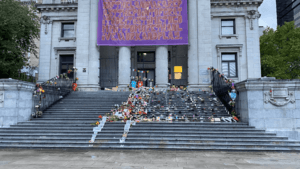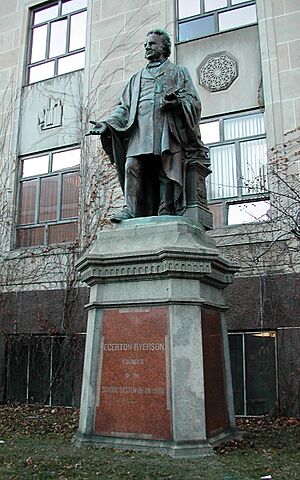Canadian Indian residential school gravesites facts for kids
Thousands of Indigenous children died while attending residential schools in Canada. The exact number is not known because many records are missing. Many of these schools had cemeteries, but most were not officially registered. This means the locations of many burial sites are now lost. The Truth and Reconciliation Commission of Canada has asked for these sites to be found, recorded, and protected.
Residential schools were special boarding schools for Indigenous children in Canada. The Canadian government ran these schools, mostly through Christian churches. The main goal was to take Indigenous children away from their families and cultures. The schools tried to make them forget their traditions and become more like non-Indigenous Canadians. Often, these schools were near churches and had their own cemeteries. Children who died at the schools were usually buried there. This was because it was cheaper than sending their bodies home. Sometimes, many children died from sickness. When this happened, they were buried together in unmarked graves because there weren't enough staff to bury them separately.
Contents
Finding Unmarked Graves
Since the 1970s, unmarked graves and possible burial sites have been found near former residential schools across Canada. Experts often use ground-penetrating radar to find these sites. So far, more than 1,900 possible graves have been identified. However, records show that over 4,100 children died while attending residential schools. The Truth and Reconciliation Commission has a list of 3,200 confirmed deaths.
The issue of unmarked graves gained a lot of attention in May 2021. An expert found signs of 215 "probable burials" at the former Kamloops Indian Residential School. This number was later changed to 200. After this, similar announcements followed from other schools. These discoveries led to memorials, protests, and even some church fires. It also led to Pope Francis visiting Canada in 2022 to apologize.
Reactions and Responses
After the discoveries, people set up memorials in many places. These included the Vancouver Art Gallery, the Ontario Legislative Building, and various government and church buildings.
Prime Minister Justin Trudeau ordered that flags on all federal buildings be flown at half-mast. This was a sign of respect and mourning.
Government Funding
On June 2, 2021, the Canadian government promised C$27 million. This money was given to the National Centre for Truth and Reconciliation. It was meant to help find and identify unmarked graves. Several provincial governments also promised money for these searches:
- British Columbia: C$12 million
- Alberta: C$8 million
- Saskatchewan: C$2 million
- Manitoba: C$2.5 million
- Ontario: C$10 million
Calls for Investigations and Changes
Some Members of Parliament, Mumilaaq Qaqqaq and Charlie Angus, asked the Justice Minister to start an independent investigation. They wanted to look into possible crimes against humanity in Canada.
Some communities in British Columbia, Alberta, Northern Saskatchewan, and New Brunswick cancelled their Canada Day celebrations. This was to show respect for the children who died.
The Canadian School Boards Association asked for a new curriculum. They want Indigenous history to be taught in all schools across Canada, from kindergarten to Grade 12. In New Brunswick, the Education Minister said their curriculum would be changed to teach about the province's Indigenous day schools.
The United Nations Human Rights Office and UN human rights experts asked Canada and the Holy See (the Vatican) to investigate the discoveries. Other countries like China and Russia also supported these calls.
Changing Names and Monuments

The discovery of possible graves at Kamloops led to calls for changes. People wanted to rename places and remove monuments that honored figures linked to colonial views or policies against Indigenous peoples. Some of these figures included Egerton Ryerson, John A. Macdonald, and James Cook. For example, the doors of St. Paul's Cathedral in Saskatoon were covered in paint on June 24.
Even though Canada is a constitutional monarchy (where the King or Queen follows the government's advice), some royal monuments were affected. A school named after Prince Charles was renamed. Statues of Queen Victoria and Queen Elizabeth II were also toppled by protesters in Winnipeg.
In 2021, Canadian news editors voted "Children who never returned from residential schools" as the top Canadian Newsmakers of the Year. This showed how important and impactful this topic was to the country.
See also
- Christianity and colonialism
- Genocide recognition politics § Canada
- List of Indian residential schools in Canada
- Snuneymuxw First Nation § Nanaimo Indian Hospital


